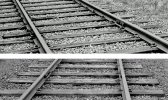You are using an out of date browser. It may not display this or other websites correctly.
You should upgrade or use an alternative browser.
You should upgrade or use an alternative browser.
7mm Heybridge Basin
- Thread starter Richard Gawler
- Start date
Threadmarks
View all 18 threadmarks
Reader mode
Reader mode
Recent threadmarks
Ideas for Presentation . . train displays Landscaping . . ideas for the basin water Backdrop Panels Operations . . traction, "last vehicle" and frog polarity corrections [ a watery mishap near Newdigate Colliery ] New [ a watery mishap on the line to Blaina and Pantyffynnon Collieries ] New Spots for Photography New Operations . . shunting ropes and chains Newsimond
Western Thunderer
Richard, the key measurement is not Back to Back, but Back to Front (gauge point) - and in this case the tread width.
There was a very good treatise on the interaction between track and wheels, but I can’t remember where - might be the Templot forum, the S4 society or the G0G website.
0MF uses the inherent slack in 0F to reduce the checkrail gaps, and thus improve appearance by having a less “scale” gauge.
S7 starts with scale gauge, check rails and wheels - I think the check gaps are the same as 0MF (or should they be t’other way about
You’ll not mix the two successfully as if you overlay a scale drawing of one on the other so one rail gauge face coincides, there is no “common zone” at the other rail.
I’m out for Mother’s Day today but can sketch it on CAD when I get a chance.
There was a very good treatise on the interaction between track and wheels, but I can’t remember where - might be the Templot forum, the S4 society or the G0G website.
0MF uses the inherent slack in 0F to reduce the checkrail gaps, and thus improve appearance by having a less “scale” gauge.
S7 starts with scale gauge, check rails and wheels - I think the check gaps are the same as 0MF (or should they be t’other way about

You’ll not mix the two successfully as if you overlay a scale drawing of one on the other so one rail gauge face coincides, there is no “common zone” at the other rail.
I’m out for Mother’s Day today but can sketch it on CAD when I get a chance.
Richard Gawler
Western Thunderer
There's no need for a CAD sketch. I have had a go, it didn't work out, and I'll stay with 0-MF for my hand-built track.
Osgood
Western Thunderer
What clearance do you have between the flange outer face distance and running rail inner distance?The distance across the inner rails of my inset track measures just below 28.6 mm; so an easy working clearance for a Minerva wagon with 28.8 mm B2B on a straight track.
....
If it is greater than 0.2mm, I would think the chances of the Minerva wagon flange inner faces aligning perfectly with the ends of your check rails tin order to avoid a 'clunk' when entering the inner check rail section of track are pretty remote due to just a 0.2mm clearance between flange B2B and inner rail distance - hence the need for a tapered lead-in on the outer edge of the check rails?
Richard Gawler
Western Thunderer
What clearance do you have between the flange outer face distance and running rail inner distance?
Everything works fine. Every wagon I possess, rolled to and fro, Brio-style, with the model skewed fully counter-clockwise and also clockwise, runs perfectly. The two four-wheel coaches are good as well. I think this is more useful to know than trying to calculate clearances from wheels which aren't always as orthogonal on their axles as we might like.
My long(ish) view at the moment is to lay the rest of the track and wire it all up and enjoy the bare layout. Any real running problems will show up when I use it in anger. Scenics can follow later; I need some weather warm enough to let me spray the track outdoors.
Last edited:
Richard Gawler
Western Thunderer
I am part way through making the track for the passenger platform, so this seems a good time for a second mock up.
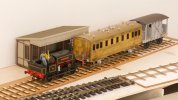
A local passenger train clears the fouling point.
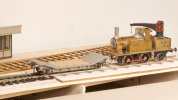
The headshunt is long enough for Nellie and my longest wagon. The NER Lomac is so modern (1913) it can only appear during the dismantling of the railway.
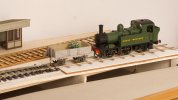
This young lady shouldn't really appear at all but I succumbed because I admired the engineering of the chassis. My high frequency lighting unit lights up the firebox glow feature.
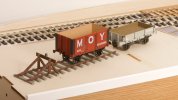
The plan shows a tiny stabling point here but I think an equally tiny goods yard is better. There is room for a loading platform in front and a small office as a partial view blocker behind.
I see Michael (@michael mott) has a track spiking task too. I don't envy you at all, though I suppose a G3 spike is easier to see and hold.

A local passenger train clears the fouling point.

The headshunt is long enough for Nellie and my longest wagon. The NER Lomac is so modern (1913) it can only appear during the dismantling of the railway.

This young lady shouldn't really appear at all but I succumbed because I admired the engineering of the chassis. My high frequency lighting unit lights up the firebox glow feature.

The plan shows a tiny stabling point here but I think an equally tiny goods yard is better. There is room for a loading platform in front and a small office as a partial view blocker behind.
I see Michael (@michael mott) has a track spiking task too. I don't envy you at all, though I suppose a G3 spike is easier to see and hold.
Last edited:
Richard Gawler
Western Thunderer
Back to the cut-down staples I trialled on my fiddle yard . . . the track beside the passenger platform is Kalgarin code 100 rail spiked onto C&L plywood sleepers, with spikes cut from Rexel no. 56 staples.
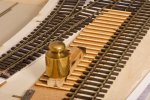
Peco flexi track put to use as a flexi curve. The ends of the sleepers are in line with the ends of the Peco ones.
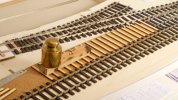
Working from right to left, and sliding the wood block along to settle each fresh sleeper into its PVA foundation.
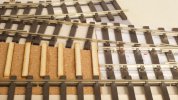
The Setback point seems to be of freelance design while the A6 is a model of an A6. The timbering here is never going to look terribly good; I have taken the two longest timbers off the A6 and shuffled the sleepers around a bit.
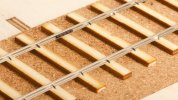
This track has my first two electric spikes, these follow a suggestion by Tony @Osgood. The fishplates are Kalgarin ones marketed for their BH rail but they seem to fit here. I had to remind myself, FB track usually has its rail joints centred on sleepers not set between them.
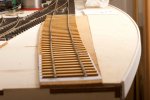
Inspired by @Jordan I have allowed myself to make this track less than perfect, as though a few sleepers have settled and would benefit from shifting an inch sideways. The error is about 0.5 mm. The error ought to be in placing the sleepers on the baseboard not placing the rail on the sleepers, but this would be a lot more difficult. Hopefully all will look reasonable after painting.
Edit: I've removed all of the Kalgarin fishplates on the inside of the code 100 track - they fouled the wheel flanges . The fishplates I have stuck onto code 124 rail work fine.
. The fishplates I have stuck onto code 124 rail work fine.

Peco flexi track put to use as a flexi curve. The ends of the sleepers are in line with the ends of the Peco ones.

Working from right to left, and sliding the wood block along to settle each fresh sleeper into its PVA foundation.

The Setback point seems to be of freelance design while the A6 is a model of an A6. The timbering here is never going to look terribly good; I have taken the two longest timbers off the A6 and shuffled the sleepers around a bit.

This track has my first two electric spikes, these follow a suggestion by Tony @Osgood. The fishplates are Kalgarin ones marketed for their BH rail but they seem to fit here. I had to remind myself, FB track usually has its rail joints centred on sleepers not set between them.

Inspired by @Jordan I have allowed myself to make this track less than perfect, as though a few sleepers have settled and would benefit from shifting an inch sideways. The error is about 0.5 mm. The error ought to be in placing the sleepers on the baseboard not placing the rail on the sleepers, but this would be a lot more difficult. Hopefully all will look reasonable after painting.
Edit: I've removed all of the Kalgarin fishplates on the inside of the code 100 track - they fouled the wheel flanges
 . The fishplates I have stuck onto code 124 rail work fine.
. The fishplates I have stuck onto code 124 rail work fine.
Last edited:
Richard Gawler
Western Thunderer
Photo of Mendlesham, 1920's? from an unknown internet source. copyright with the original owner.View attachment 207696
A mixture of one and two spikes with staggered joints and short rail lengths. No sole plates.,
Richard,
I suspect 30ft rails were more common.
Rob
I do listen, honest, but sometimes I seem to forget too quickly.
I have now removed the rest of the fishplates and put all fresh ones back, this time to represent nominal 30 not 40 foot rail. It is fortunate the sleeper pitch is constant and doesn't need to close up at rail joints

I don’t know what the offset should be (or even if it was standardised), but supposing the rail was delivered in 30 foot lengths then one length would have to be cut to make a start. I am imagining the offset is symetrical, so 15 feet. There is still time to pull the fishplates off and do them again if more information comes to light.
PhilH
Western Thunderer
I had to remind myself, FB track usually has its rail joints centred on sleepers not set between them.
Really ???? - I beg to differ.
Osgood
Western Thunderer
Well......the Middy appeared to be the exception to the rule:
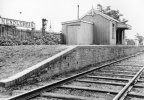
Looks like there is astaple track spike below the fishplate (unlike one of the other pics I found but cannot replicate here).
Note also staggered joints.
Found a couple more shots both within platforms, but no evidence either way yet of joint location on open track - will keep looking.

Looks like there is a
Note also staggered joints.
Found a couple more shots both within platforms, but no evidence either way yet of joint location on open track - will keep looking.
Last edited:
Osgood
Western Thunderer
Evidence of sleepers under, and staggered, joints in several photos in Payne's MSLR book - also one photo showing a non-staggered joint.
Also a couple of early Lynn & Fakenham / Eastern & Midlands Rly photos in Clarke's book show joints over sleepers.
Perhaps influenced by the standard 'temporary track' practice of the contractors who built these lines?
Also a couple of early Lynn & Fakenham / Eastern & Midlands Rly photos in Clarke's book show joints over sleepers.
Perhaps influenced by the standard 'temporary track' practice of the contractors who built these lines?
Yorkshire Dave
Western Thunderer

This track has my first two electric spikes, these follow a suggestion by Tony @Osgood. The fishplates are Kalgarin ones marketed for their BH rail but they seem to fit here. I had to remind myself, FB track usually has its rail joints centred on sleepers not set between them.
Once you have worked out the rail lengths and joints....
To create the illusion of rail joints on flex track/rail I cut a half depth notch in the top of the rail with a fine razor saw. The fishplate effectively hides the uncut section at the bottom of the BH rail.
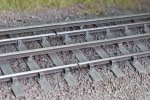
And on this P48 US flex track I completed the illusion of the gap at the bottom of the FB rail with a fine black marker pen. And yes the rail joints are staggered.
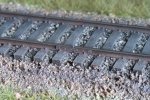
Richard Gawler
Western Thunderer
Really ???? - I beg to differ.
A couple of examples from the Cleobury Mortimer & Ditton Priors Light Railway
The R.H.D.R. at Hythe
The W.H.R. at Dinas
Phil I stand corrected. I would have been better to write, I had to remind myself, FB track can have its rail joints centred on sleepers not set between them.
Richard Gawler
Western Thunderer
Well......the Middy appeared to be the exception to the rule:
Well, the Tanat Valley Light Railway had spiked FB rail with at least one rail joint centred over a sleeper. Looking at WREN, WJ "The Tanat Valley Light Railway", Oakwood Press 1979, this is in the photograph of no. 1196 near Pedairffordd on the front cover of the book and repeated on page 26.
This line also had staggered rail joints, there is an example in the photo of no. 1308 at Llangynog on page 52. Here, the offset is perhaps 3 or 4 feet.
Richard Gawler
Western Thunderer
To create the illusion of rail joints on flex track/rail I cut a half depth notch in the top of the rail with a fine razor saw. The fishplate effectively hides the uncut section at the bottom of the BH rail.
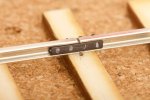
I put off the idea of notches because I thought they would look overscale; having cut a few I am sure they are worthwhile. This is a Kalgarin 'Permaway' fishplate. With the bolt detail trimmed off and the gauge at 31.5 mm, samples of my Slater's, Dapol and Minerva wheels all pass freely.
I met code 100 rail in my Tri-ang System 6 track in the 1970s, my hobby seems to have gone full circle. My eyesight was sharper in those days . . . the empty hole looks like a spike to me, and the moulding nib doesn't show up at all

PhilH
Western Thunderer
Richard,
Sorry to interject again, but I think with a joint on a sleeper the rail would still be spiked, see Osgood's photo in Post #150 - you could stick one in the hole each side and cut off most of the head.
You might be better off with etched fishplates, such as these available from Stephen Freeman:- Fishplates
Sorry to interject again, but I think with a joint on a sleeper the rail would still be spiked, see Osgood's photo in Post #150 - you could stick one in the hole each side and cut off most of the head.
You might be better off with etched fishplates, such as these available from Stephen Freeman:- Fishplates
Richard Gawler
Western Thunderer
I am not sure. There are a few Peco rail joiners holding rails together in the model, and the moulded cosmetic fishplates help to hide these.
Furthermore, this is an 0 gauge layout, not a Scale 7 one. Any photograph showing the moulded fishplates will probably include some wheels as well, and they usually scream “model”. I need my occupational spectacles to see the moulded fishplates with any great clarity, and so I can’t really see a benefit in using etched ones. I might go half way, and use some lengths of brass strip, without the bolt detail. I will need something like this anyway, to do the BH to FB transitions.
It is good to know the choices I have. The plan is to finish building the track in a functional sort of a way, wire it up and arrange a mechanism for the hand built A6. Then run some trains. I want to treat the extra spikes and maybe thinner fishplates as a scenic task before painting.
Furthermore, this is an 0 gauge layout, not a Scale 7 one. Any photograph showing the moulded fishplates will probably include some wheels as well, and they usually scream “model”. I need my occupational spectacles to see the moulded fishplates with any great clarity, and so I can’t really see a benefit in using etched ones. I might go half way, and use some lengths of brass strip, without the bolt detail. I will need something like this anyway, to do the BH to FB transitions.
It is good to know the choices I have. The plan is to finish building the track in a functional sort of a way, wire it up and arrange a mechanism for the hand built A6. Then run some trains. I want to treat the extra spikes and maybe thinner fishplates as a scenic task before painting.
Last edited:
Richard Gawler
Western Thunderer
To recap slightly, I want this diorama to be a photographic base as well as a test track and a learning project for 7 mm scale. To this end, I have settled on bullhead track for the goods siding. Bullhead will look sensible under just about any item of rolling stock from Victorian times to the present day.
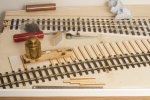
The road bed is two layers of card. I rather overdid the application of PVA glue (new scale!) and this had to be sanded flat afterwards. The bit of copper pipe was my rolling pin to squeeze out the worst of the surplus.
I have settled on a nominal sleeper pitch of 2ft 9in compared with 2ft 6in for the FB track. Both dimensions are somewhat notional, the idea is to represent a lightly-laid railway. If I discover the pitch at the Middy was smaller I can remember this for the next layout. Meanwhile, the code 100 rail looks about right to me with a 2ft 6in pitch so the code 124 can take slightly more.
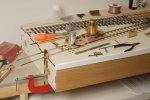
The rail is Peco from the flexi in the previous photo and the chairs are from Kalgarin.
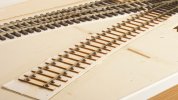
I have set the gauge here to 32 mm. Partly because I may end up with a buffer stop intended for 0 gauge, and partly because it seemed easier. The exit from the Setrack point is quite abrupt (especially after I trimmed it down), and I couldn't quite see how to flare down to 31.5 mm and then out to 32 mm in the space available.
I am imagining, the railway would lay a siding using standard lengths of rail, so I have closed up the sleepers and notched the rails to represent 30 ft lengths of rails. Because of this, the siding is two sleepers shorter than planned for.
This is my first attempt using ABS chairs on ply sleepers and assembly turned out easier than I expected. The solvent is butanone, and if a chair needs to be moved a knife blade slipped underneath it will free it.

The road bed is two layers of card. I rather overdid the application of PVA glue (new scale!) and this had to be sanded flat afterwards. The bit of copper pipe was my rolling pin to squeeze out the worst of the surplus.
I have settled on a nominal sleeper pitch of 2ft 9in compared with 2ft 6in for the FB track. Both dimensions are somewhat notional, the idea is to represent a lightly-laid railway. If I discover the pitch at the Middy was smaller I can remember this for the next layout. Meanwhile, the code 100 rail looks about right to me with a 2ft 6in pitch so the code 124 can take slightly more.

The rail is Peco from the flexi in the previous photo and the chairs are from Kalgarin.

I have set the gauge here to 32 mm. Partly because I may end up with a buffer stop intended for 0 gauge, and partly because it seemed easier. The exit from the Setrack point is quite abrupt (especially after I trimmed it down), and I couldn't quite see how to flare down to 31.5 mm and then out to 32 mm in the space available.
I am imagining, the railway would lay a siding using standard lengths of rail, so I have closed up the sleepers and notched the rails to represent 30 ft lengths of rails. Because of this, the siding is two sleepers shorter than planned for.
This is my first attempt using ABS chairs on ply sleepers and assembly turned out easier than I expected. The solvent is butanone, and if a chair needs to be moved a knife blade slipped underneath it will free it.
Yorkshire Dave
Western Thunderer
I have set the gauge here to 32 mm. Partly because I may end up with a buffer stop intended for 0 gauge, and partly because it seemed easier. The exit from the Setrack point is quite abrupt (especially after I trimmed it down), and I couldn't quite see how to flare down to 31.5 mm and then out to 32 mm in the space available.
I am imagining, the railway would lay a siding using standard lengths of rail, so I have closed up the sleepers and notched the rails to represent 30 ft lengths of rails. Because of this, the siding is two sleepers shorter than planned for.
Rather than take up valuable track length with a buffer stop you could always have a sleeper built buffer stop at the end similar to the one at Wood Siding on the Brill Branch of the Metropolitan Railway. This was surfaced and doubled up as a milk churn loading platform.
B/W print; Wood Siding Underground station, Brill branch, Metropolitan line, 1935 | London Transport Museum
Threadmarks
View all 18 threadmarks
Reader mode
Reader mode

